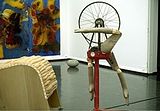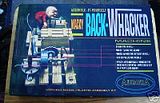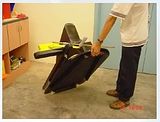Introduction
The utilitarian philosopher Jeremy Bentham (1748-1832) was one of the first writers to contemplate the possibility that corporal punishment might be administered by a machine rather than by a human being. In The Rationale of Punishment
he wrote:
"Of all these different modes of punishment, whipping is the most frequently in use; but in whipping not even the qualities of the instrument are ascertained by written law: while the quantity of force to be employed in its application is altogether intrusted to the caprice of the executioner. He may make the punishment as trifling or as severe as he pleases. He may derive from this power a source of revenue, so that the offender will be punished, not in proportion to his offence, but to his poverty. If he has been unfortunate, and not able to secure his plunder, or honest, and has voluntarily given it up, and thus has nothing left to make a sop for Cerberus, he suffers the rigour -- perhaps more than the rigour -- of the law. Good fortune and perseverance, in dishonesty, would have enabled him to buy indulgence.
"The following contrivance would, in a measure, obviate this inconvenience:-- A machine might be made, which should put in motion certain elastic rods of cane or whalebone, the number and size of which might be determined by the law: the body of the delinquent might be subjected to the strokes of these rods, and the force and rapidity with which they should be applied, might be prescribed by the Judge: thus everything which is arbitrary might be removed. A public officer, of more responsible character than the common executioner, might preside over the infliction of the punishment; and when there were many delinquents to be punished, his time might be saved, and the terror of the scene heightened, without increasing the actual suffering, by increasing the number of the machines, and subjecting all the offenders to punishment at the same time."
It is quite remarkable how popular this idea has proved among humorists, cartoonists and apparently some perfectly serious designers and inventors. Although few such machines have actually been built, the notion has recurred frequently over the centuries in a variety of media. Here are several examples of how it has been imagined. They are presented in roughly chronological order.
Russia, 19th century
This caning machine appeared in a Russian book and looks as if it might be of Russian origin. Note the queue of offenders awaiting punishment. Each in turn is held down on a bench, over a cushion which raises up his bared buttocks. This design, which looks quite practicable, may be from the 19th century. (Russia had judicial whipping for peasants until the beginning of the 20th century.)
Germany, 1856
Here from Germany is a fantasy of automated mass spanking on a truly industrial scale. It comes from Die Körperstrafen bei allen Völkern ("Corporal punishment amongst all peoples"), by Dr Richard Wrede (1898), who attributes it to a magazine, "Fliegenden Blättern", of 1856. It does not look to me as if it could have worked very effectively.
United Kingdom?, 19th century
Another 19th-century example of mass-production punishment, source unknown.
Australia, 1879

Twin cartoons from Cole's Funny Picture Book No 1, published in Melbourne by E.W. Cole. These came with a long humorous text, full of surreal fantasy, the gist of which is that the first "Patent Whipping Machine for Flogging Naughty Boys in School", operated by hand, proved ineffective, whereas its steam-powered replacement produced the desired tearful response on the part of the culprits. (Thanks to Glen Ralph of the Wilmar Library for discovering the origin of this; his detailed research is written up in Notes and Curieux No 6, Wilmar Library, Lockleys, Sep 2003.)
Germany, 1899
In this ingenious but surely rather impractical German design, the culprits are carried round and round the contraption for repeated doses of pain from the whizzing wheel of canes. The drawing appeared in Hansen, Stock und Peitsche im 19. Jahrhundert ("The cane and the whip in the 19th century"), Dresden, 1899.
United Kingdom, 1902
This cartoon by P.V. Bradshaw from the Boys Own Paper in 1902 imagines a machine, the "Automatic Castigator", whose main purpose seems to be to save the lazy headmaster the trouble of getting up out of his chair. The inset drawing warns of the danger of getting caught up in it himself: "Awful result of a new headmaster examining the machine and touching a wrong button". The controls include "Regulator for intensity of strokes". This machine also talks: "I'm sorry to see you here again so soon, my boy. Much as it will pain me, and you, I shall have no alternative but to administer a thrashing..."
United States, 1909
Frame from a comic strip, "Little Nemo in Slumberland", by Winsor McCay, in the New York Herald, 7 February 1909. The story is set in a school, where the principal has installed the new "Patent Automatic Corrector, Electric Manipulator and Spanking Administrator".
United States, date unknown
"The Mother's Kitchen Help and Ready Reckoner", including a machine labelled "Chastiser".
United Kingdom, possibly 1920s
Here is one of many British boys' school stories in which a CP machine appears, this time wielding birches, probably from the interwar period.
United Kingdom, possibly 1930s
Another illustration from an English boys' school story. Not having the story itself to hand, I am not sure who the sinister hooded figures are supposed to be. Note the transition from birch in the previous example to cane here.
United States, 1930
Unlike many of the machines in our collection, this "Lifting and spanking machine" really existed. It was designed for Masonic lodges and college fraternities and such like to use in their initiation ceremonies, and is advertised here for $32.50 in the 1930 "Fraternal Supply Catalog" of Messrs DeMoulin Bros & Co. of Illinois. See more from this catalogue here
.
United States, date unknown
This is in a picture agency's library but I have not been able to find out where it originally came from or what it is precisely. From the clothes of the boy being disciplined, it might be 1930s or 1940s but that is only a guess. The machine appears real, but it is hard to see from this picture quite how it works. One can make out what appears to be a small wooden paddle.
United States, 1940s
This machine for paddling soldiers who fail to shoot properly was featured in the US edition of Popular Mechanics during World War II.
United States, 1950s?


Here is Mr Wilber Herring's self-operated kicking machine in North Carolina. The sign says "Have you ever said 'I want to kick myself'? Here's your chance".
United States, 1960s
This is said to be from a science-fiction comic strip called "Richie Rich".
Denmark, 1967, and Norway, 2001

The Bergen (Norway)-based installation artist Ruth Tulle made this spanking machine in 2001. It was an exact replica of one that had been built by her father, the Rev. Jens Koefoed-Jespersen, in 1967 for punishing his 12 children in their Danish home. For the full story, see Ruth Tulle's website
, and on this page
are more views of the machine in the Bergen Kunsthalle.
United Kingdom, 1960s
Not so much a spanking machine as a kicking machine, in a 1960s British kids' comic.
United Kingdom, c.1960s or 1970s
From a similar source and in rather similar vein, here is a slippering machine.
United States, 1965

The "Assemble-it-yourself Wacky Back-Whacker" was a toy for kids. The makers, Aurora, produced a vast range of plastic models in kit form, some of them serious real things like cars and planes but also, as in this case, jocular fantasies.
Germany, 1970s
Inventor Otto Tuchenhagen, with 80 patents already to his name, submitted this design to the German Patent Office, and it was written up at length in a perfectly serious magazine (title and date not to hand). He thought the reintroduction of judicial CP for young delinquents would save the taxpayer a lot of money on reformatories and prisons. His machine, of which he proposed installing 2,000 examples all over West Germany (as it then was), would deliver a judicial caning in a humane and consistent manner.
The offender would be sentenced by the court to a suitable number of strokes. The sentence would be encoded on a magnetic card. The offender strips to his underpants, enters the caning room alone, and inserts the card in the machine. He receives the strokes in his own time, pressing down on the handle when he feels ready to take the next one. The cane will operate only when he is standing on the platform and holding on to the handle with both hands, thus ensuring that he is in the correct position to receive his punishment. An echo sounder on the column holding the cane checks that the miscreant has not cheated by putting padding such as a newspaper down the back of his pants.
All is done automatically: no one else is present in the room, so there is no risk of any cruelty or humiliation. Once the ordeal is over, the magnetic card now records that the penalty has been administered; the offender takes his card back to the court and is discharged.
Unaccountably, the authorities failed to take up Herr Tuchenhagen's scheme.
United States, 2000s
Here is a Spanking Bike -- an exercise bike converted to a spanking machine by a biking group in California. "The faster you pedal, the harder you get spanked. We were amazed at how many kids got on this thing, you'd figure they got enough ass whooping at home." Unfortunately this picture does not show how the machine works in detail ....
... However, the following video clip from 2007 is either of the same machine or something more or less identical, and gives a clearer impression of the mechanism:
This video clip is not currently available.
United States, 2000s
This video clip shows the inventor of a paddling machine testing his prototype on himself. The design is based on paddles that operate by gravity, which does not look to me as if it provides sufficient force to inflict a proper punishment.
This video clip is not currently available.
United States, 2001
US Patent No 6293874 is entitled "User-operated amusement apparatus for kicking the user's buttocks", by inventor Joe W. Armstrong of Tennessee. The patent application explains that one of the machine's advantages, compared with some other designs, is that it does not require the resetting of the apparatus or repositioning of the user between blows. For more on this, see this page
. The design is virtually identical to that of Mr Wilber Herring in North Carolina (see 1950s, above).
Singapore, 2003


In the Tan Kah Kee Young Inventors' Award 2003, this very smart caning machine for schools won a commendation award for its inventor, Tan Song Koy of Yuying Secondary School. The entries in this annual competition are entirely serious and useful gadgets. This one was up against a cockroach catcher and an improved helmet for cyclists, among other things. Its aim is "to deliver even and consistent caning strikes to all offenders".
Song Koy had witnessed the punishment of six boys at his school, and felt it was "unfair when his friend, being the first to be caned, received the hardest strikes ... The discipline master (DM) was tired by the time he caned the last offenders, therefore his strike is lighter in comparison". (This is, in part, the argument put forward by Jeremy Bentham in the 18th century in the quote at the beginning of this article.)
The offender stands on the yellow platform with his front against the red pad, and bends over the pillar, grasping the red handles low down on the other side. In so doing, he presents the tautened seat of his pants to the cane, which is on a spring and which strikes when a catch is released, unfortunately not clearly shown in the pictures. The machine folds up when not in use, and has two wheels at the base enabling it to be pulled easily from one classroom to the next.
There is no word on whether the machine was ever put to actual use, but anecdotal reports from the school where it was designed and built are of traditional canings by a human DM. I am pretty sure that in practice it would be very difficult to get a machine to replicate the accuracy, power and timing (and especially that crucial flick of the wrist at the last moment) of a skilled discipline master, such as is employed by many secondary schools in Singapore. An easier way, perhaps, to solve the problem identified by Song Koy would be not to punish six students all at one go, but instead to give the DM a 10-minute break between canings.
